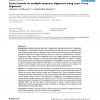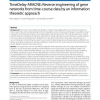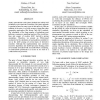718 search results - page 10 / 144 » Timing Yield Calculation Using an Impulse-Train Approach |
BMCBI
2007
13 years 7 months ago
2007
Background: Multiple sequence alignment is fundamental. Exponential growth in computation time appears to be inevitable when an optimal alignment is required for many sequences. E...
BMCBI
2010
13 years 7 months ago
2010
Background: One of main aims of Molecular Biology is the gain of knowledge about how molecular components interact each other and to understand gene function regulations. Using mi...
ICCAD
2005
IEEE
14 years 4 months ago
2005
IEEE
Based on a timing yield model, a statistical static timing analysis technique is proposed. This technique preserves existing methodology by selecting a “device file setting” ...
ICASSP
2010
IEEE
13 years 6 months ago
2010
IEEE
The problem of interference alignment in time-varying MIMO interference channels is considered. To reduce complexity, an adaptive algorithm for beam vector design is proposed base...
FPL
2008
Springer
13 years 9 months ago
2008
Springer
Today, quasi-Monte Carlo (QMC) methods are widely used in finance to price derivative securities. The QMC approach is popular because for many types of derivatives it yields an es...



